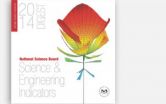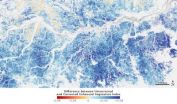(Press-News.org) This news release is available in German.
Information transmission at the synapse between neurons is a highly complex, but at the same time very fast, series of events. When a voltage change, the so-called action potential, reaches the synaptic terminal in the presynaptic neuron, calcium flows through voltage-gated calcium channels into the presynaptic neuron. This influx leads to a rise in the intracellular calcium concentration. Calcium then binds to a calcium sensor in the presynaptic terminal, which in turn triggers the release of vesicles containing neurotransmitters into the synapse. The released neurotransmitter binds to postsynaptic receptors, leading to a response in the postsynaptic neuron. The coupling between calcium channels and sensors of exocytosis is key in determining the speed, timing and probability of synaptic transmission. Two forms of coupling occur in the brain: in tight, or „nanodomain" coupling, channels and sensors are located very close to each other, with 10 to 20 nm distance, while in loose, or „microdomain" coupling, channel and sensor are further apart, in the region of around 100 nm. Previous research suggests that loose coupling occurs in synapses during early development, while tight coupling is observed in the mature central nervous system. In their current paper, Vyleta and Jonas ask whether, given the advantages of tight coupling – including the speed, temporal precision, fidelity and energy efficiency of synaptic transmission – any synapse in the mature central nervous system makes use of loose coupling? And if it does so, what are the consequences for the function of synaptic transmission?
A specific synapse in the hippocampus, the mossy fiber synapse on CA3 pyramidal neurons, which is accessible to direct recording using the patch-clamp method and shows a high degree of plasticity, was the focus in this research (Figure). To investigate whether loose or tight coupling occurs in this synapse, Vyleta and Jonas made use of calcium chelators, which capture calcium ions on their way from the source to the sensor, to investigate the timescale and distance of coupling. If only the fast-acting chelator, BAPTA, can inhibit exocytosis and synaptic transmission, but the slow chelator EGTA cannot, tight coupling is at work, while in loose coupling, both fast and slow chelators can inhibit transmission. As both fast and slow chelators suppress transmission in the synapse under investigation, results suggest loose coupling between channels and sensors, with a mean coupling distance of around 75 nm.
Why does loose coupling, which is likely slower and has less fidelity than tight coupling, exist in the mossy fiber-pyramidal neuron synapse? Further results by Vyleta and Jonas show that due to loose coupling, fast endogenous calcium buffers in the synapse can act as a brake on transmission, controlling how likely the initial release of neurotransmitter is. Loose coupling provides the time frame for endogenous buffers to act on synaptic transmission. The saturation of endogenous buffers after repeated stimulation may also promote facilitation, the phenomenon in which impulses are more likely to generate action potentials when they closely follow a prior impulse.
The new findings challenge the view that loose coupling is a developmental phenomenon, demonstrating instead that coupling is regulated in a synapse-specific way. Loose coupling is predominantly used at dynamic and plastic synapses, both in the developing and the mature brain. Together with fast endogenous calcium buffers, loose channel-sensor coupling may provide the molecular framework for presynaptic plasticity, a hallmark of hippocampal neurons.
INFORMATION: END
Loose coupling between calcium channels and sensors
Science paper by IST Austria scientists reports first evidence for 'microdomain' coupling at a mature central synapse and explores the implications for synaptic plasticity
2014-02-06
ELSE PRESS RELEASES FROM THIS DATE:
US lead in science and technology shrinking
2014-02-06
The United States' (U.S.) predominance in science and technology (S&T) eroded further during the last decade, as several Asian nations--particularly China and South Korea--rapidly increased their innovation capacities. According to a report released today by the National Science Board (NSB), the policy making body of the National Science Foundation (NSF) and an advisor to the President and Congress, the major Asian economies, taken together, now perform a larger share of global R&D than the U.S., and China performs nearly as much of the world's high-tech manufacturing as ...
Prickly protein
2014-02-06
A genetic mechanism that controls the production of a large spike-like protein on the surface of Staphylococcus aureus (staph) bacteria alters the ability of the bacteria to form clumps and to cause disease, according to a new University of Iowa study.
The new study is the first to link this genetic mechanism to the production of the giant surface protein and to clumping behavior in bacteria. It is also the first time that clumping behavior has been associated with endocarditis, a serious infection of heart valves that kills 20,000 Americans each year. The findings were ...
NASA study points to infrared-herring in apparent Amazon green-up
2014-02-06
For the past eight years, scientists have been working to make sense of why some satellite data seemed to show the Amazon rain forest "greening-up" during the region's dry season each year from June to October. The green-up indicated productive, thriving vegetation in spite of limited rainfall.
Now, a new NASA study published today in the journal Nature shows that the appearance of canopy greening is not caused by a biophysical change in Amazon forests, but instead by a combination of shadowing within the canopy and the way that satellite sensors observe the Amazon during ...
Valentine's Day advice: Don't let rocky past relations with parents spoil your romance
2014-02-06
University of Alberta relationship researcher Matt Johnson has some Valentine's Day advice for anybody who's had rocky relations with their parents while growing up: don't ...
Falcon feathers pop-up during dive
2014-02-06
Similar to wings and fins with self-adaptive flaps, the feathers on a diving peregrine falcon's feathers may pop-up during high speed dives, according to a study published in PLOS ONE on February 5, 2014 by Benjamin Ponitz from the Institute of Mechanics ...
New, high-tech prosthetics and orthotics offer active life-style for users
2014-02-06
TAMPA, Fla. (Feb. 5, 2014) – Thanks to advanced technologies, those who wear prosthetic and orthotic devices ...
University of Montana research shows converting land to agriculture reduces carbon uptake
2014-02-06
MISSOULA – University of Montana researchers examined the impact that converting natural land to cropland has on global vegetation growth, as measured by satellite-derived ...
Bacterial fibers critical to human and avian infection
2014-02-06
Escherichia coli—a friendly and ubiquitous bacterial resident in the guts of humans and other animals—may occasionally colonize regions outside the intestines. There, it can have serious consequences for health, ...
Study suggests whole diet approach to lower CV risk has more evidence than low-fat diets
2014-02-06
Philadelphia, PA, February 5, 2014 – A study published in The American Journal of Medicine ...
Bundles of nerves and arteries provide wealth of new stem cell information
2014-02-06
A new Ostrow School of Dentistry of ...
LAST 30 PRESS RELEASES:
The Ceramic Society of Japan’s Oxoate Ceramics Research Association launches new international book project
Heart-brain connection: international study reveals the role of the vagus nerve in keeping the heart young
Researchers identify Rb1 as a predictive biomarker for a new therapeutic strategy in some breast cancers
Survey reveals ethical gaps slowing AI adoption in pediatric surgery
Stimulant ADHD medications work differently than thought
AI overestimates how smart people are, according to HSE economists
HSE researchers create genome-wide map of quadruplexes
Scientists boost cell "powerhouses" to burn more calories
Automatic label checking: The missing step in making reliable medical AI
Low daily alcohol intake linked to 50% heightened mouth cancer risk in India
American Meteorological Society announces Rick Spinrad as 2026 President-Elect
Biomass-based carbon capture spotlighted in newly released global climate webinar recording
Illuminating invisible nano pollutants: advanced bioimaging tracks the full journey of emerging nanoscale contaminants in living systems
How does age affect recovery from spinal cord injury?
Novel AI tool offers prognosis for patients with head and neck cancer
Fathers’ microplastic exposure tied to their children’s metabolic problems
Research validates laboratory model for studying high-grade serous ovarian cancer
SIR 2026 delivers transformative breakthroughs in minimally invasive medicine to improve patient care
Stem Cell Reports most downloaded papers of 2025 highlight the breadth and impact of stem cell research
Oxford-led study estimates NHS spends around 3% of its primary and secondary care budget on the health impacts of heat and cold in England
A researcher’s long quest leads to a smart composite breakthrough
Urban wild bees act as “microbial sensors” of city health.
New study finds where you live affects recovery after a hip fracture
Forecasting the impact of fully automated vehicle adoption on US road traffic injuries
Alcohol-related hospitalizations from 2016 to 2022
Semaglutide and hospitalizations in patients with obesity and established cardiovascular disease
Researchers ‘listen in’ to embryo-mother interactions during implantation using a culture system replicating the womb lining
How changing your diet could help save the world
How to make AI truly scalable and reliable for real-time traffic assignment?
Beyond fragmented markets: A new framework for efficient and stable ride-pooling
[Press-News.org] Loose coupling between calcium channels and sensorsScience paper by IST Austria scientists reports first evidence for 'microdomain' coupling at a mature central synapse and explores the implications for synaptic plasticity



